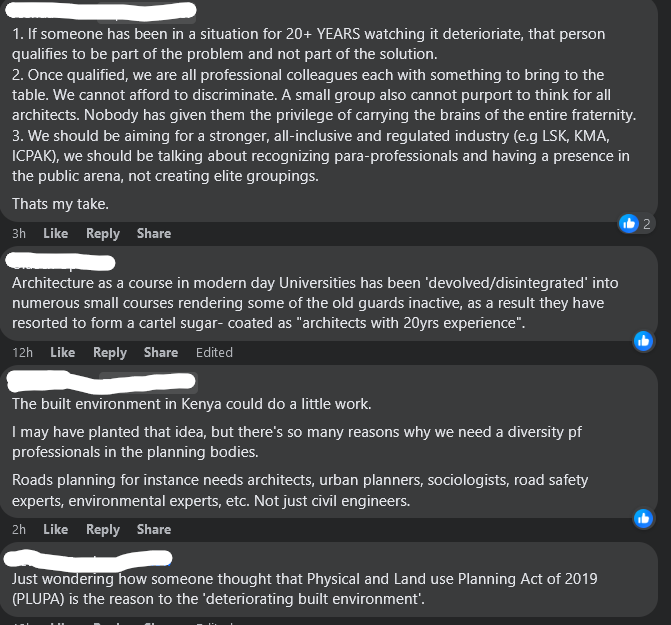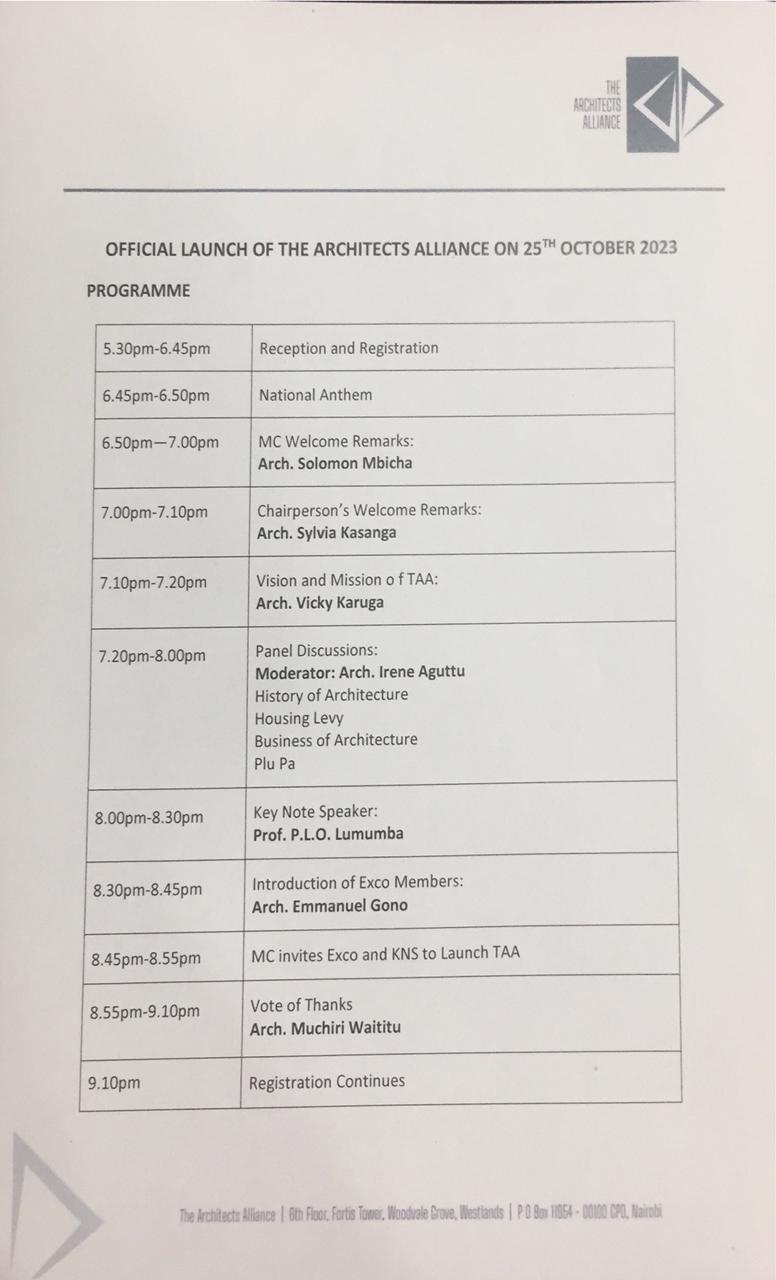
Senior Architects have allied to push their agendas in the physical and built environment. As members, the Alliance will have architects who have practised in the industry for over the past 20 years.
The Architects Alliance (TAA), launched last week in Nairobi, will also play three primary functions: advocacy, being a think tank and finally, a home for architects, according to the Alliance’s president Sylvia Kasanga.
“We have observed with dismay the deterioration of our physical and built environment, and we are of the opinion that the way to fix this is to involve every citizen in appreciating the value that good physical environments bring and the importance of preserving the heritage handed down to us so that we can pass it on to the future generations,” said Ms Kasanga, a former nominated Senator in the 12th Parliament.
“The consequence is that the entire populace will understand their role as physical environment wardens and will resist the destruction of the environment.
“All citizens will appreciate and value good built and physical environments and will demand for it in their neighbourhoods and communities.”
While all this appears to be in goodwill, why is the membership limited to those who have practised for over 20 years? Are these senior members not the actual cause of our situation as a country in the construction industry? What new ways or methods shall they adopt to bring a change?
Why won’t these senior members work within the Architectural Association of Kenya(AAK) framework to bring about the changes they want? We should remember that the AAK has been under the leadership of these senior members for decades since its foundation. What did they do then? What did they achieve apart from being gatekeepers of the industry?
It is already a challenge to train and register as an Architect. As of 2022, the examination fee was about KSh. 30,000, exclusive of processing fee, CPDs or site training for candidates.
It’s worth noting that the Architectural Association of Kenya(AAK) started becoming vibrant and impactful when young architects took over the leadership a few years ago. Check the AAK website to confirm some of the vibrant projects and programs they initiated over the past few years. Programs like the MLIKA MJENGO initiative are game changers and can have a massive impact on the industry if supported by everyone, including these Senior Architects.
Is it that young architects(digital) are giving the senior members(analogue) a run for their money, so now they want to bring new hurdles to the practice?
It’s already tough being an Architect in this country. How many architects are unemployed? Yearly, universities keep churning out graduate architects who remain jobless for years. Some have become hopeless and turned into other hustles like selling mitumba (second-hand clothes) clothing to earn a living; others have become academic writers!
Many are suffering even as the industry is getting overtaken by masqueraders. Architects ought to be some of the wealthiest professionals in this country! However, they are not. Some even resort to borrowing/hiring cars to attend client meetings, as they have to impress the clients. Otherwise, they will not get the projects.
Graduate architects get paid peanuts, as little as KSh—20,000 per month.
Many projects are going on in this country, yet architects are jobless. Everywhere you turn, massive buildings are coming up, yet architects are unemployed.
These are the evils all architects should fight, primarily through the AAK. Divisions and discrimination through age will not work.
Even if these senior architects want to be heard, they should voice their issues within AAK, perhaps through the AAK’s College of Fellows. If this does not work for them, then they should create another chapter through AAK. Or better, all the Built Industry Professionals should come together and form a union to advocate for all the professionals in the Built Industry.
If these senior architects think that their outfit will bring any change, they should learn something from what happened to Kenya’s engineering fraternity.
Senior engineers in Kenya decided that being a professional engineer is insufficient, so they created a ‘Consulting Engineer’ category through the Engineers Act. This was not enough for these fellows; in addition to the ‘Fellow’ membership category of the Institution of Engineers of Kenya (IEK), they created another category called ‘Eminent Engineers Forum’, which now indirectly runs the IEK. As of the writing of this article, the Chair of the Eminent Engineers Forum is the Chairman of the Engineers Board of Kenya (EBK, the legal regulator of engineering in Kenya), while his son is the CEO of the Institution of Engineers of Kenya (IEK, the association of all engineers in Kenya). This is such a thorny issue with engineers that it found its way to the courts, courtesy of a few brave engineers who saw the absurdity of the issue. Kenyans, our love for titles, positions and classes has brought us here! What have these Eminent Engineers Forum and Consulting Engineer elite classes achieved in all their existence? They are supposed to be the custodians of the profession, yet they have nothing to show. What engineering books have they written? What standards and manuals have they developed for Kenyans?
These so-called senior engineers lobbied to strike out the engineering technologists and technicians from the Engineers Act. Engineering technologists and technicians were forced to lobby for creating another entity, ‘The Kenya Engineering Technology Registration Board (KETRB)’, through the Engineering Technology Act. Look at what discrimination has brought to the engineering fraternity! I am even made aware that Graduate Members of the Institution of Engineers of Kenya (IEK) do not have voting rights, yet they are the majority. These are the types of chaos which now permeate the construction industry. If professionals are divided and discriminated against by their seniors, why are we expecting sanity? Don’t con artists, masqueraders, and fake professionals thrive in such chaos?
Will architects follow the same route?
How many years it might take to become a member of this Alliance:
- Years at the university: 6
- Years of Post Graduate Training before undertaking BORAQs exams: 2
- Years of Practice before joining the Alliance: 20
- Pre-Primary, Primary and Secondary School Years: 20
- Minimum age: 6+2+20+20= 48 years
Our senior colleagues, let’s work together with the junior colleagues, and we will achieve a lot together.




PS.
Senior Kenyans and middle-aged Kenyans(from the age of 48 ) are perhaps the most significant cause of the situation we are in as a country. Tribalism, Corruption, and Nepotism became entrenched in the country because of this generation. It is said that they all had to join the National Youth Service(NYS), but one wonders if their training made any difference. They always brag about this. It is the generation which suffered child abuse (physical and psychological) through caning by their teachers and parents. However, what difference did it make? They look back at their upbringing as an example of how children should be raised!
It is said that Kenya’s economy was at par with those of Asian countries, such as South Korea, Malaysia, China, and Singapore, in the 1960s. Nevertheless, when the country was handed over by the whites(colonialists), our economy was surpassed by these Asian countries. What is in the defense of these senior Kenyans? Where were they when their counterparts in other countries were working to develop their countries? Even today, these senior Kenyans are the greatest gatekeepers in any industry! as they hold key leadership positions.


